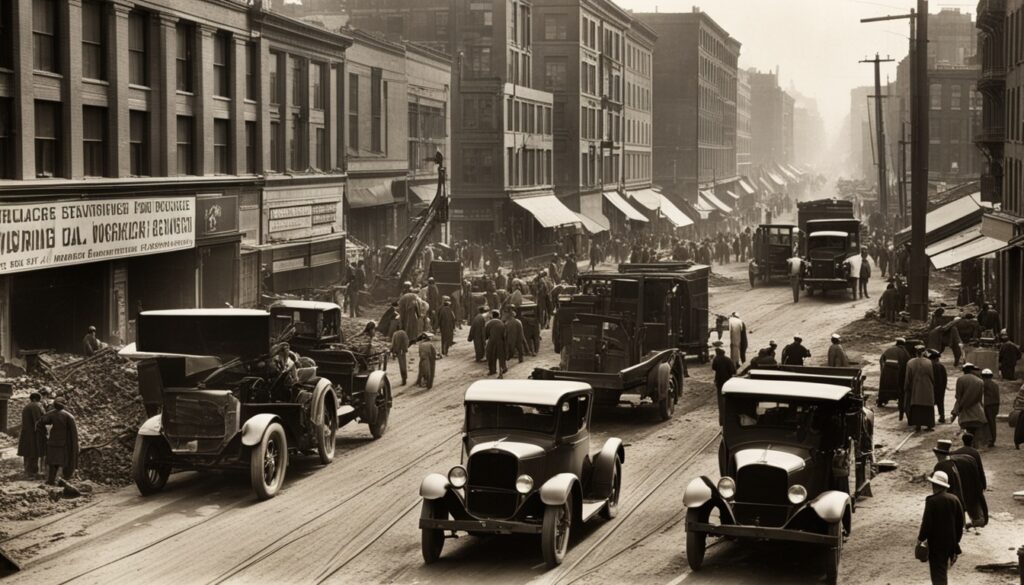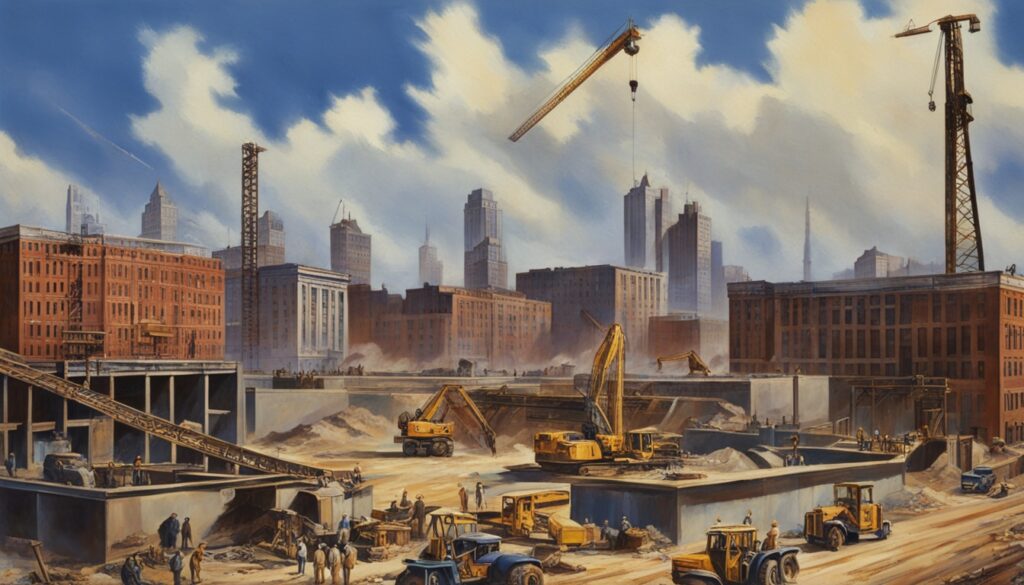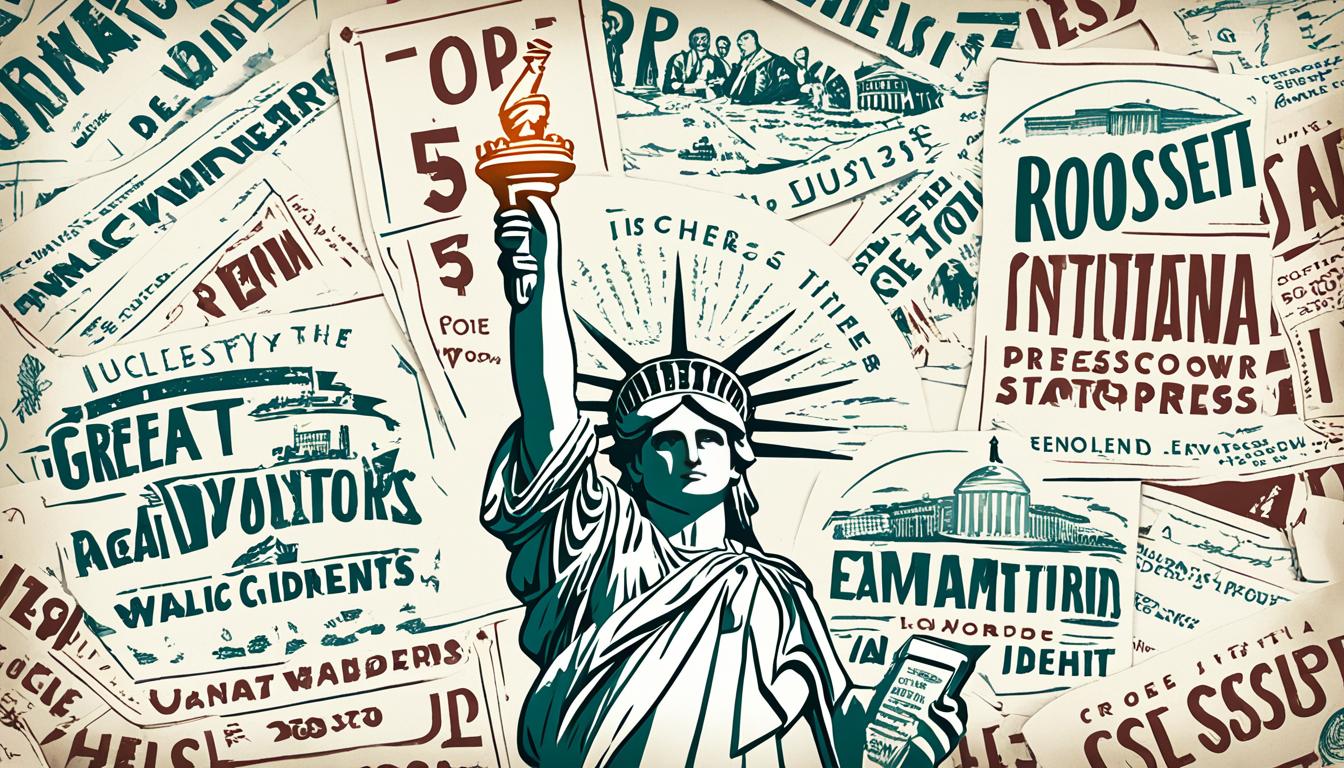“As an Amazon Associate I earn from qualifying purchases.”
Picture a moment when the American Dream was fading away. The stock market crashed, factories shut down, and lines for food grew long. This was the tough truth of the Great Depression. It was an economic disaster that left many without jobs, money, or hope. Then, something changed. Franklin D. Roosevelt and his New Deal programs brought a ray of hope.
Roosevelt’s fireside chats were like a calming voice in the chaos, showing a way out. His plans to recover the economy were daring and stirred up debates. The goal was simple; he wanted to bring back a sense of normalcy and help those who had been left behind. Programs like the Works Progress Administration (WPA) and the Federal Emergency Relief Act quickly got into action. They aimed to restart businesses, and support families having a hard time.
Rebuilding wasn’t easy. There was a lot of opposition to the National Industrial Recovery Act. And not everything went smoothly. But Roosevelt kept going. He deeply believed that the government must step in, strong and supportive, especially in rough times.
Key Takeaways
- The Great Depression left millions unemployed and financially devastated.
- Roosevelt’s New Deal programs aimed to revive the economy and provide social welfare support.
- Initiatives like the WPA, banking reforms, and agricultural acts sought to stabilize industries and assist struggling families.
- Challenges and opposition arose, but Roosevelt’s determination drove the recovery efforts forward.
- The New Deal cemented the federal government’s role in economic intervention and social safety nets.
Franklin D. Roosevelt’s New Deal
Franklin D. Roosevelt faced the worst economic times with the Great Depression. He quickly started his New Deal plans. On March 4, 1933, Roosevelt made his first speech as president. He promised to fight the crisis with all he had.
Roosevelt’s Inaugural Address and Call for Action
Roosevelt’s first speech was powerful. He talked about a strong effort to fix the country. The next day, he announced a four-day bank holiday. This was to stop a collapse in the banking system. It led to the Emergency Banking Act. This law helped fix and reopen troubled banks, making people believe in the system again.
The First Hundred Days and Initial Reforms
The “First 100 Days” were full of quick actions and changes. Fireside chats from FDR aimed to get people back into the banks. He wanted to kickstart the economy. Key laws were passed, like ending Prohibition. The Agricultural Adjustment Act focused on helping farmers. And, the National Industrial Recovery Act supported the rights of workers to form unions.
In 1933, places like Toledo and Lowell had 80-90% of people out of work. Roosevelt’s New Deal tried to help in many ways. He introduced twelve important laws in his first three months. These laws, like the Glass-Steagall Act, gave the government new powers to fight the Depression’s hard times.
New Deal Programs and Agencies
President Roosevelt acted fast as the Great Depression hit hard. He started the new deal programs and agencies to help the economy. Key efforts included the Agricultural Adjustment Act, the Tennessee Valley Authority Act, and the National Industrial Recovery Act.
Agricultural Adjustment Act
The Agricultural Adjustment Act changed farming in a big way. It paid farmers not to grow crops. This lowered supply and increased crop prices. The goal was to balance the farming sector which had too much supply and not enough demand.
Tennessee Valley Authority
The Tennessee Valley Authority Act let the government build dams on the Tennessee River. This work aimed to stop floods and create cheap hydroelectric power. The TVA was a huge public project that showed FDR’s support for ambitious government efforts.

National Industrial Recovery Act
The National Industrial Recovery Act (NIRA) made it easier for workers to join unions and bargain collectively. It also allowed companies to work together on prices and wages. Additionally, it led to the Public Works Administration, which built things to create jobs.
These new deal programs and agencies were key parts of FDR’s fight against the Depression. Not everyone liked them, but they showed Roosevelt was ready to try new and bold plans to help the nation.
| Program/Agency | Purpose | Notable Features |
|---|---|---|
| Agricultural Adjustment Act | Stabilize agricultural prices | Paid farmers to leave fields fallow |
| Tennessee Valley Authority | Flood control and hydroelectric power | Constructed dams along Tennessee River |
| National Industrial Recovery Act | Boost industry and jobs | Guaranteed workers’ right to unionize, suspended antitrust laws |
Banking Reforms and Economic Recovery Efforts
During the Great Depression, President Roosevelt made big moves to fix the country’s struggling banking system and start an economic recovery. He signed two major laws: the Emergency Banking Act and the Glass-Steagall Act. These laws began important financial reforms.
Emergency Banking Act
In March 1933, the country faced a banking crisis, so Roosevelt took action. He called for a four-day break from bank activities. This time off helped the government check bank finances and decide what to do.
Thanks to this act, almost all banks reopened and people felt more secure about their money. The move was key in rebuilding trust in the banking system.
This Act gave the president more control over money, separate from the Federal Reserve. It also let the government give money to banks through the RFC, a bit like the 2008 TARP program.
Glass-Steagall Act
Soon after, Roosevelt signed the Glass-Steagall Act. This was a major banking reform law. It aimed to make people trust banks again by keeping certain banking types apart, to avoid bad decisions and too much risk.
One very important part of the Glass-Steagall Act was creating the FDIC. This meant people’s bank savings were insured, making it safer for them. This helped lower bank failures from thousands in 1933 to only 61 in the next year.
| Legislation | Key Provisions | Impact |
|---|---|---|
| Emergency Banking Act |
|
Stabilized banking system, restored public confidence |
| Glass-Steagall Act |
|
Reduced bank failures from 4,000+ in 1933 to 61 in 1934 |
These banking reforms and economic recovery efforts played a huge part in the U.S. economy’s bounce back from the Great Depression.
Unemployment Relief and Public Works
In the Great Depression’s worst times, joblessness hit record highs across cities in the U.S. Toledo, Ohio, saw 80% of its people out of work. And in Lowell, Massachusetts, a stunning 90% were without jobs. These numbers were staggering and required bold, new ways to create jobs.

Works Progress Administration (WPA)
in 1935. This was the start of something big. It gave jobs to millions by building things like post offices, bridges, and schools all over the country.
It wasn’t just a short-term help. The WPA built things that still help communities today.
Another vital part of FDR’s plans was the
Public Works Administration
. It aimed to fund major
public works
and projects like airports and hospitals. This effort fixed the economy’s problems, created jobs, and improved the nation’s facilities.
| Program | Purpose | Notable Projects |
|---|---|---|
| Works Progress Administration (WPA) | Provided employment through small-scale public works projects | Post offices, bridges, schools, highways, parks |
| Public Works Administration | Funded large-scale infrastructure projects to stimulate the economy | Airports, dams, hospitals, housing projects |
These unemployment relief and public works measures did more than get people back to work. They also left a lasting imprint. The buildings, roads and more still help and beautify our nation today.
Supporting Workers and Labor Unions
In the Great Depression, President Franklin D. Roosevelt saw how crucial workers and were. He and his team made a big move to help them. On July 5, 1935, they passed the National Labor Relations Act. Most people know it as the .
National Labor Relations Board: Safeguarding Workers’ Rights
The set up the National Labor Relations Board (NLRB). This group made sure was fair and stopped bosses from breaking the rules. They could really enforce these laws. This meant they could look out for , hold fair union votes, and make sure unions were heard.
Surging Union Membership and Improved Conditions
The had a big impact. By 1940, almost 9 million folks were in . Thanks to the act, workers had better conditions, pay, and benefits. This time marked a big change for worker rights.
The Wagner Act was a game-changer for the labor movement, empowering workers to collectively bargain for fair treatment and better working conditions.
The act’s impact could be seen all through the 1930s. Union membership kept growing. By 1937, about 8 million workers had joined unions. They fought for what they needed and helped shape America’s working future.
The Second New Deal
By 1935, many in the US faced tough times despite the initial efforts of President Roosevelt’s New Deal. Unemployment soared, especially in cities such as Toledo and Lowell. The Great Depression gripped the nation tightly, showing the need for aggressive reforms.
Therefore, Roosevelt introduced the Second New Deal. This included many new programs aiming to boost the economy and help those in need. One key program was the Works Progress Administration (WPA) expansion. It aimed to employ millions on everything from public projects to cultural activities.

One of the Second New Deal’s most important outcomes was the Social Security Act of 1935. This vital law provided pensions for the elderly, unemployment insurance, and support for children and the disabled. It was a big help for those facing the Depression’s hard times.
The test of our progress is not whether we add more to the abundance of those who have much; it is whether we provide enough for those who have too little. – Franklin D. Roosevelt
Roosevelt aimed to significantly change the country. He wanted the government to protect its people better in hard times. This was a key aspect of his plan.
Social Welfare Initiatives
During the Great Depression, the U.S. faced hard times. Franklin D. Roosevelt’s government saw a big need for a strong social welfare system. This system would help the most vulnerable people. In 1935, the groundbreaking Social Security Act became law. It guaranteed old-age pensions for many retired Americans. It also started a unemployment insurance program nationwide.
The act did more than help the elderly and jobless. It also set out to provide aid for children and disabled people. This effort marked the beginning of a system that would help during tough economic times.
Social Security Act
The Social Security Act changed how the national government saw its duty. It agreed to look after the welfare of its people. By giving out old-age pensions, it helped retired folks. This way, they could keep up their living standards during their later years.
Aid for Dependent Children and the Disabled
The act also aimed to help families and individuals in tough spots. It set aside help for dependent children and the disabled. This was a step to fight the harsh effects of poverty. It made sure every child and disabled person had a chance for a decent life.
| Program | Description | Impact |
|---|---|---|
| Old-Age Pensions | Provided financial assistance to retired Americans | Ensured a basic standard of living for the elderly |
| Unemployment Insurance | Established a nationwide system for the unemployed | Offered temporary financial relief during job loss |
| Aid for Dependent Children | Allocated resources for vulnerable families | Mitigated the impact of poverty on children |
| Aid for the Disabled | Provided support for individuals with disabilities | Enabled a dignified existence for the disabled |
The Social Security Act did more than help with immediate money problems. It started a path toward a caring and fairer society. It said everyone deserves respect, no matter their situation.
Opposition and Setbacks
Roosevelt faced many problems as he tried to push through his New Deal plans. The Supreme Court, mainly conservative, didn’t support some of his big ideas. They found some of his laws too much government power.
In 1936, this conservative court stopped the National Recovery Administration (NRA) and the Agricultural Adjustment Act (AAA). This hurt Roosevelt’s plans to get the economy going again. The next year, they ruled against most of Roosevelt’s laws, showing they didn’t like how much power the government was taking.
So, Roosevelt tried to fix this by wanting to add more people to the Supreme Court who would agree with him. He thought with new judges, they could get things done his way. But, his big plan to change the court’s balance ended up making things worse.
The Supreme Court’s resistance to the New Deal’s sweeping reforms ignited a constitutional crisis, prompting Roosevelt’s ill-fated attempt to reshape the judiciary.
Then, in 1937, the bottom fell out of the economy. This hit the New Deal really hard. As the government spent less, the economy shrank. This showed just how key the government’s help was for keeping things going.
- The Supreme Court declared the NRA and AAA unconstitutional in 1936.
- By 1936, the Court had ruled against 11 out of 16 New Deal laws.
- Roosevelt’s court packing plan in 1937 aimed to counter the conservative justices but proved politically damaging.
- An economic downturn in 1937 exposed the vulnerability of the recovery when stimulus spending was reduced.
Artistic and Cultural Programs
During tough economic times, President Roosevelt saw the value of boosting arts and culture. His efforts gave birth to the Federal Theatre Project and Federal Writers’ Project. These projects didn’t just employ artists. They also brought a mix of creative works to towns, making them richer with art.
Federal Theatre Project
The Federal Theatre Project was a key player in the arts scene. It brought together skilled artists, tech teams, and actors. Together, they staged plays that not only entertained but also taught important lessons. This arts program was more than a stage; it built bridges among neighbors by sharing art and promoting culture.
Federal Writers’ Project
The Federal Writers’ Project focused on written works. It involved writers, historians, and researchers. Their work captured different cultures and stories across America. Thanks to their books and other writings, these artists helped keep the stories of ordinary people alive.
These arts programs were over and above just helping out during hard times. They showed the world that when things look grim, creativity and cultural life can still grow. By supporting promoting culture and employing artists, the New Deal initiatives made a lasting impact on American creativity. They inspired future generations to value and create art.
Impact and Legacy
The New Deal changed America by bringing together various groups. These included unions, the working class, minorities, and thinkers. They joined to support a lively government’s efforts to boost the economy and help people.
Even though this alliance weakened over time, its key projects remain. Things like Social Security, unemployment benefits, and agricultural subsidies were started then. They have since become vital to American society.
Creation of a New Political Coalition
The New Deal made a team of unions, working-class whites, African Americans, and thinkers. They came together over the idea of a caring government that could help the poor. Their unity changed how politics worked in the U.S.
Enduring New Deal Programs
Though the group’s shape has changed, key New Deal projects are still here. Social Security, which offers help for the old and the jobless, is a big part of this. Also, the support for farmers through agricultural subsidies shows the New Deal’s ongoing impact.
Fireside Chats and Public Confidence
In the tough era of the Great Depression, President Franklin D. Roosevelt held fireside chats. These radio talks helped a lot. They made people feel more hopeful about his plans to fix the economy. The fireside chats weren’t just talks; they felt like real conversations. Roosevelt spoke in a friendly way that made him seem like a close friend to all Americans. He gave around 30 speeches from March 1933 to June 1944. Nearly 90% of American homes had radios then, so his words reached almost everyone.
These talks were a big deal. They showed how good Roosevelt was at speaking and how much he cared for the nation. He often talked about important Americans like the Founding Fathers and Abraham Lincoln. This made people feel like they were all working together, which was very uplifting.
People loved listening to Roosevelt. He got so many votes in 1932. He got 23 million popular votes more than Herbert Hoover’s 16 million. This showed how well he connected with the country.
Roosevelt won big in 1932 because people trusted him. His victory was clear, with 23 million popular votes to Herbert Hoover’s 16 million.
| Statistic | Value |
|---|---|
| Number of fireside chats | Approximately 30 speeches |
| Households with radios | Around 90% |
| Roosevelt’s popular vote | 23 million |
| Hoover’s popular vote | 16 million |
| Terms elected | Four consecutive terms |
Roosevelt saw these chats as more than just talks. They were proof of how he valued honesty and the power of the people. By explaining his plans and listening to their concerns, he brought the nation together. This helped people believe in the government’s ability to overcome the Great Depression.
Conclusion
Franklin D. Roosevelt’s New Deal initiatives were bold responses to the Great Depression. They expanded the government’s role in the economy and in helping people. Programs created back then still shape America today. FDR and his team launched many reforms to fight the crisis. These included job projects, new laws for workers, and social security.
The Great Depression hit the nation hard, with many job losses. In places like Toledo and Lowell, nearly all jobs were gone by 1933. To help fast, Roosevelt put new rules for banks, set up relief for the needy, and supported farmers. These steps made the government much more involved in solving the crisis.
In his early days as president, Roosevelt brought in several big laws. These laws aimed to help the country back on its feet. He also did something unique. He shut down all banks for a few days to fix them. Then, he reopened most, building people’s trust in the banks again.
FAQ
What was the “New Deal”?
What were some of the major New Deal programs?
How did Roosevelt address the banking crisis?
What were the “Fireside Chats”?
How did the New Deal support labor unions?
What opposition did the New Deal face?
What cultural programs emerged from the New Deal?
What was the lasting impact of the New Deal?
“As an Amazon Associate I earn from qualifying purchases.”

